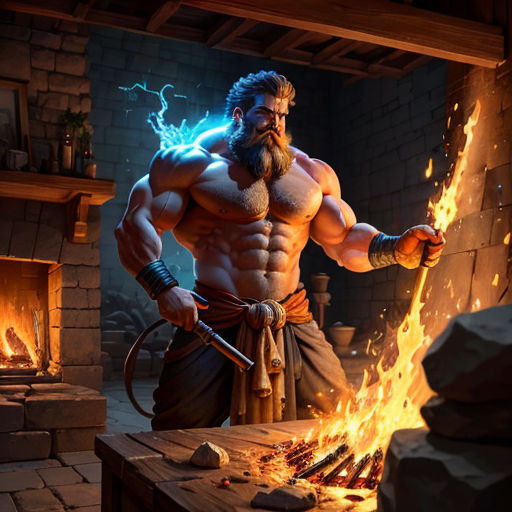Hephaestus: The Greek God of Fire and Craftsmanship
Introduction
- Hephaestus is a prominent figure in Greek mythology, known as the god of artisans, blacksmiths, carpenters, craftsmen, fire, metallurgy, metalworking, sculpture, and volcanoes.
- He is often associated with creativity, craftsmanship, and the transformative power of fire.
Mythological Background
- Hephaestus' parentage: He is the son of Zeus, the king of the gods, and Hera, the queen of the gods.
- Hephaestus' physical appearance: He is often depicted as a bearded man holding a hammer, symbolizing his association with blacksmithing and craftsmanship.
- Hephaestus' birth and early life: According to mythology, he was born weak and deformed, which led his mother Hera to throw him off Mount Olympus. He was rescued and raised by sea nymphs or Thetis, depending on the version of the myth.
Domain and Attributes
- Blacksmithing and craftsmanship: Hephaestus is the patron god of artisans, blacksmiths, carpenters, and craftsmen. He is known for his exceptional skills in creating intricate and beautiful objects.
- Fire and metallurgy: Hephaestus is closely associated with fire and the transformative power of metallurgy. He is believed to have invented various tools and techniques for working with metals.
- Sculpture and metalworking: Hephaestus is also the god of sculpture and metalworking. He is often depicted creating magnificent statues and other works of art.
Role in Greek Mythology
- Hephaestus' role as a blacksmith: He is responsible for creating the armor and weapons of the gods and heroes, including Zeus' thunderbolts and Achilles' armor.
- Hephaestus' role in the divine hierarchy: Despite his physical deformity, Hephaestus is highly respected by the gods for his craftsmanship and is considered one of the twelve Olympian gods.
- Hephaestus' relationships: He is married to Aphrodite, the goddess of love and beauty, although their relationship is often depicted as tumultuous.
Symbols and Depictions
- Hammer and anvil: Hephaestus is often depicted holding a hammer and working at an anvil, symbolizing his role as a blacksmith and craftsman.
- Forge and fire: He is associated with the forge and the transformative power of fire, representing the creative process of shaping and molding metal.
Worship and Festivals
- Temples and sanctuaries dedicated to Hephaestus: Throughout ancient Greece, various temples and sanctuaries were built in honor of Hephaestus, including the famous Temple of Hephaestus in Athens.
- Festivals and rituals: The most notable festival dedicated to Hephaestus was the Hephaestia, celebrated in Athens and other cities. It involved processions, sacrifices, and competitions.
Influence on Art and Culture
- Hephaestus' portrayal in art: He has been depicted in numerous sculptures, paintings, and other works of art, often showcasing his association with blacksmithing and craftsmanship.
- Hephaestus in literature: He appears in various ancient Greek texts, including epic poems like the Iliad and the Odyssey, where his skills as a blacksmith and craftsman are highlighted.
Legacy and Modern References
- Hephaestus' influence in modern culture: His character continues to be referenced in literature, art, and popular culture. He represents attributes such as creativity, craftsmanship, and the power of transformation.
Conclusion
- Hephaestus, the Greek god of artisans, blacksmiths, carpenters, craftsmen, fire, metallurgy, metalworking, sculpture, and volcanoes, holds a significant place in Greek mythology and is revered for his exceptional skills and creativity.
- His association with fire, craftsmanship, and transformative power makes him a fascinating and influential deity in ancient Greek culture.








0 comments:
Posting Komentar